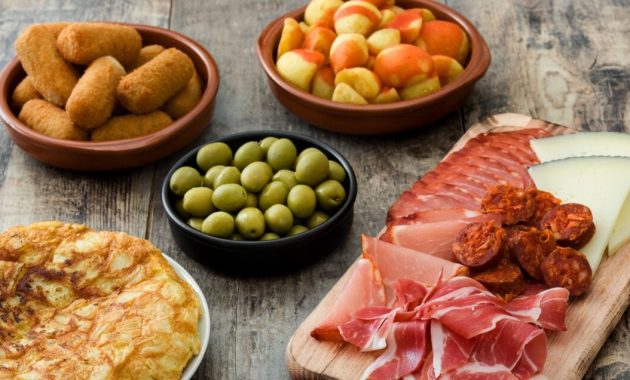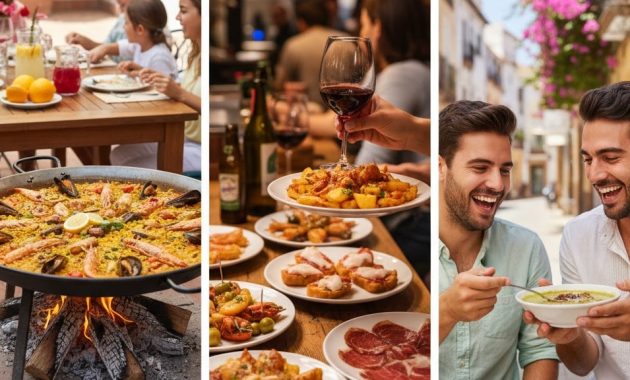A Taste of Spain in Every Bite
The first time you sit down to eat in Spain, something magical happens — the world slows down. The sun dips lower, plates begin to fill the table, and laughter blends with the clinking of glasses. Food here isn’t just sustenance — it’s rhythm, culture, and connection. Whether you’re nibbling on tapas in Seville, savoring seafood paella by the coast of Valencia, or indulging in pintxos in the lively bars of San Sebastián, Spanish cuisine is a story told through every dish. In this Spain Food Guide, we’ll explore the country’s regional flavors — from the olive oil-soaked heart of Andalusia to the avant-garde kitchens of Catalonia — and help you eat your way across one of the world’s richest culinary landscapes.
Andalusia: The Birthplace of Tapas

Southern Spain greets you with warmth — in its people and on its plates. Andalusia is the spiritual home of tapas, those irresistible small plates that turn any meal into a social feast.
In Seville, wander into a neighborhood bar and order jamón ibérico, slices of cured ham so tender they almost melt. Pair it with salmorejo, a creamy tomato and bread soup, and a glass of fino sherry.
Head to Granada, where tapas often come free with your drink — it’s a tradition that feels like a friendly wink from the locals. Don’t miss gazpacho, Andalusia’s famous chilled tomato soup, perfect for a hot afternoon.
Valencia: The Home of Paella

No visit to Spain is complete without tasting paella, and there’s no better place than Valencia — its birthplace.
Traditional paella valenciana is made with rabbit, chicken, green beans, and saffron-infused rice cooked over an open flame. Locals take this dish seriously, and rightfully so.
For seafood lovers, paella de marisco (seafood paella) offers prawns, mussels, and squid cooked in golden broth. Visit a beachside chiringuito (beach bar), and you’ll hear the crackle of the rice — the sound of authentic Spanish happiness.
Catalonia: Innovation Meets Tradition

Catalonia is where creativity and tradition dance together. In Barcelona, food is an art form — from Michelin-starred restaurants to cozy bodegas tucked in narrow streets.
Try crema catalana, the local cousin of crème brûlée, or pa amb tomàquet, toasted bread rubbed with tomato, olive oil, and salt — simple, but soul-satisfying.
Seafood shines here too, with dishes like suquet de peix (fisherman’s stew) and grilled calçots (green onions) dipped in romesco sauce. Catalonia’s chefs have redefined Spanish cuisine, blending rustic flavors with modern techniques.
Basque Country: Pintxos and Perfection

Up north, the Basque Country takes small bites to new heights. In San Sebastián, pintxos (bite-sized tapas served on bread) fill the counters of every bar — from marinated anchovies to mini steak sandwiches topped with peppers.
Grab a drink, hop from bar to bar, and experience the Basque way of dining — casual, social, and full of flavor. The Basque Country is also home to world-renowned restaurants like Arzak and Mugaritz, where culinary artistry meets innovation.
Madrid: A Melting Pot of Spanish Flavors

In Spain’s capital, every region’s flavor converges. Madrid may not have the sea, but it makes up for it with heart and heritage.
Start your day with churros con chocolate — crispy dough sticks dipped in thick, velvety chocolate. For lunch, nothing beats cocido madrileño, a hearty chickpea stew with meats and vegetables served in courses.
Stop by Mercado de San Miguel, a gourmet food market near Plaza Mayor, where you can sample cheeses, hams, olives, and wines from all across Spain — a true feast for the senses.
Galicia: Where the Sea Feeds the Soul

In Spain’s lush northwest, Galicia is a seafood paradise. The air smells of salt and seaweed, and every dish feels like a love letter to the ocean.
Try pulpo a la gallega (Galician octopus), tender slices of octopus sprinkled with paprika and sea salt, drizzled in olive oil. Pair it with a glass of crisp Albariño wine and fresh empanada gallega (savory pie with tuna or meat).
Dining here feels earthy and authentic — you’re never far from the sea, and it always finds its way onto your plate.
Castilla y León: The Land of Roasts and Red Wine
In the heart of Spain, meals are hearty and slow-cooked. Segovia is famous for cochinillo asado (roast suckling pig), tender and crispy-skinned, while Burgos is known for its creamy queso de Burgos cheese.
Pair these with a glass of Ribera del Duero wine, one of Spain’s finest reds, and you’ll understand why the locals take dining so seriously — every meal is a celebration.
Canary & Balearic Islands: Sunshine and Seafood
Spain’s islands bring their own unique twist to the table.
In Mallorca, try sobrasada, a soft, spreadable chorizo-like sausage with a hint of spice. In Ibiza, local dishes like bullit de peix (fish stew) remind you that the sea is never far.
Over in the Canary Islands, you’ll find papas arrugadas — “wrinkled potatoes” served with spicy mojo sauce. It’s humble, flavorful, and deeply satisfying — the perfect island comfort food.
Spanish Drinks to Try
- Sangria – Fruity red wine punch, best enjoyed under the sun.
- Tinto de Verano – A lighter, refreshing mix of wine and soda.
- Cava – Spain’s sparkling wine from Catalonia.
- Horchata – Sweet, milky drink made from tiger nuts (Valencia specialty).
- Café con leche – Strong Spanish coffee with milk, perfect for mornings.
Sweet Endings: Desserts Worth Traveling For
Spain’s desserts are a reflection of its warmth and sweetness. Try churros con chocolate in Madrid, tarta de Santiago (almond cake) in Galicia, or flan anywhere across the country.
And don’t skip turrón, Spain’s beloved nougat candy — especially around Christmas!
FAQs About Spain Food Guide
What time do Spaniards usually eat meals?
Lunch is around 2–3 PM, dinner starts late — often after 9 PM.
Are tapas free everywhere in Spain?
Not everywhere — free tapas are common in Granada, less so in Madrid or Barcelona.
What’s the difference between tapas and pintxos?
Pintxos are Basque-style tapas, usually served on bread and held by a toothpick.
Spain Food Guide : Is paella eaten all over Spain?
Yes, but it originated in Valencia and that’s where you’ll find the most authentic version.
Are there vegetarian options in Spanish cuisine?
Absolutely — tortilla española, pisto (Spanish ratatouille), and patatas bravas are great meat-free choices.
What’s the most popular dessert in Spain?
Churros con chocolate and crema catalana top the list.
What is Spain’s national dish?
Many would say paella, but tapas culture defines Spanish dining more broadly.
Is tipping common in Spain?
Not mandatory — rounding up the bill or leaving 5–10% is polite but not expected.
Spain Food Guide : Are Spanish wines good?
Yes! Try Rioja, Ribera del Duero, and Albariño for local excellence.
Is street food common in Spain?
Not as much as in Asia, but local markets often sell incredible snacks and bites.
Can you find halal or vegan food in Spain?
In big cities like Madrid, Barcelona, and Valencia — yes, easily.
Are food festivals in Spain worth attending?
Absolutely! Events like La Tomatina and Tapas Fairs offer the best of Spanish food culture.
Final Verdict: A Journey Through Flavor
Spain’s culinary world isn’t just about eating — it’s about living. Every region, every dish, and every glass of wine tells a story of heritage, passion, and community.
From sunlit paella pans on the Valencian coast to laughter-filled tapas bars in Seville, Spanish food captures the heart of its people — generous, flavorful, and full of life.
So, pack your appetite and curiosity, because your next meal in Spain might just be your favorite memory.
Ready to taste Spain? Start with this Spain Food Guide and let your journey begin — one delicious bite at a time.
